Sunday, May 19 2013
As most of you know, we recently released our newest model, MIPS4/MF+
- MIPS3/MF is still a very good model, but MIPS4/MF+ produces a "smoother ride" along the way.
Therefore, for individual investors, MIPS4/MF+ is the model you should use if you are going to
trade with "leverage".
- Of course, with MIPS4/MF+ signals, you do not have to trade with leverage.
- You can trade SPY or any ETF that "correlates" well with the SPY, like IWM and QQQ.
- Many of our customers trade 1/3 each of SPY, IWM, QQQ.
More aggressive investors, however, could do even better trading SSO (the "double leverage" SPY) using MIPS4/MF+ signals with some portion of their MIPS money.
Since I am "in-the-middle" of the risk tolerance crowd, I trade double leverage SSO on long signals and single leverage SH on short signals
- but, if you trade with leverage, you can choose whichever of the trading strategies below that
fits your own risk tolerance.
The following are three MIPS "Performance Reports" using MIPS4/MF+ signals in the period 2007-3/31/13:
ETFs Traded_________ ........Comp Gwth............Max DD
1) SPY long / SH short.............33.0%................. -10.63%
2) SSO long / SH short............54.1%................. -16.13%
3) SSO long / SSO short..........72.0%................. -18.14%
Hope this helps.
Thursday, May 16 2013
For the MIPS Members that do not remember, we do have an indicator on our website that shows roughly how MIPS sees the strength in a current market.
Market Strength Indicator
Even though it does not represent signal changes per se, we do have a graph on our homepage (1/3 down in the middle) for what we call the MIPS "Market Strength Indicator" (MSI). The MSI is a "mix" of some of our most reliable indicators. We believe that MSI does represent the "direction" of market strength (up or down), BUT IS NOT INTENDED TO BE A SIGNAL CHANGE INDICATOR. That said, the MIPS models usually do not issue a trade signal change when the MSI is really strong or really weak (but it can, with a true out-of-the-blue key reversal pattern).
We usually recommend that new MIPS users NOT join in on an existing signal if the slope of the MSI is trending against the signal (like don't go long when the MSI is trending down). Once in, however, simply follow the MIPS signals AND please DO NOT try to use the MSI as a signal change indicator.

This graph is usually updated about twice a week
Saturday, May 11 2013
As with almost everything in this world, the behavior of the stock market is made up of actions from millions of people. And, as with almost everything in this world, the stock market does kind of repeat itself. The $64,000 question is what is repeating and when?
This week I saw a talking head on CNBC discussing what was going on in the market and why, and if the current 5-year bull market would continue. Like most others, he gave a very nondescript answer. His short answer (and my interpretation of his answer) was that the action of the stock market would follow one of the options below:
1) Rational Exuberance - 60% (that is, keep going up as it should)
2) Irrational Exuberance - 30% (that is, going up faster, even though it should not)
3) Market Crash - 10% (that is, a complete reversal from today's bull market action).
This reminds me of three market behaviors of the Nasdaq in the 1990's (when Alan Greenspan coined the term "Irrational Exuberance").
Graph 1 - Rational Exuberance
This graph shows the Nasdaq from 1985-1995, when the index TRIPLED, but did so because technology was booming. This fits "Rational Exuberance" because everyone was happily making money on the high growth of companies like Microsoft, Oracle, Cisco, etc. In this 10-year period, the Nasdaq rose in value from about 250 to 775, ending with "overbought" conditions, nose-bleed P/E ratios (Cisco had a P/E ratio of over 100), etc. Then, the pundits were were crying, GET OUT!!!
Were they right?
 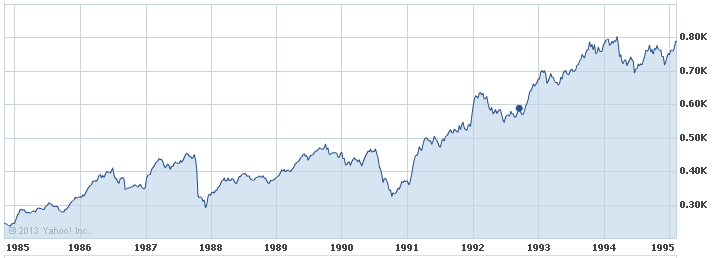
Graph 2 - Irrational Exuberance
Of course, the pundits were right about the fundamentals, but DEAD WRONG about the Nasdaq market performance
- the proof lies in the following 5 years' performance [that is, in the time period of 1995-2999 (Graph 2)]
- this is when everyone (especially the little guys) went into panic buying ("Irrational Exuberance")
- the net result over this 5-year period was that the Nasdaq WENT UP OVER SIX-FOLD, from 775 to 5000, with
crazy things like Cisco's P/E ratio growing to over 400, Yahoo's market cap being more than the GDP of Iceland, etc
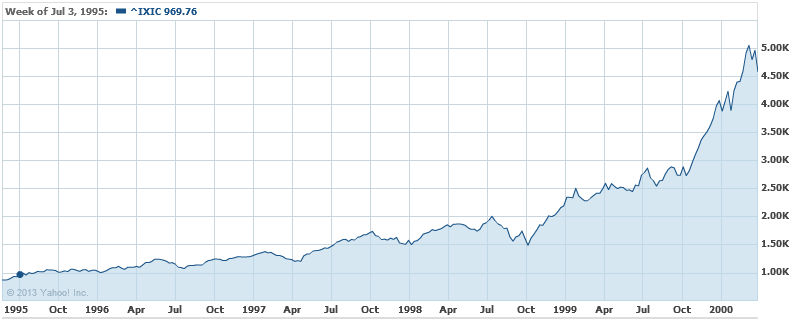
Graph 3 - Market Crash
We all know that US stock market indices went up in smoke after the year 2000, but getting out in 1995 was way too early.
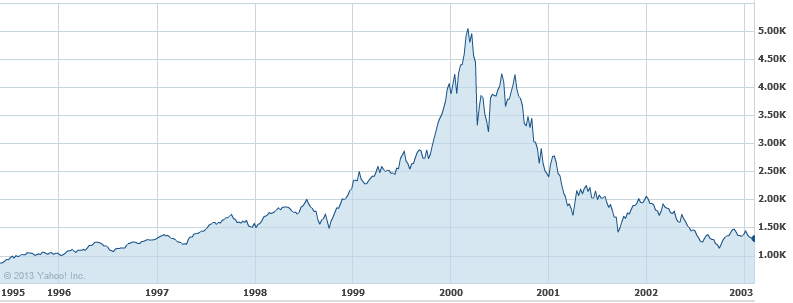
OUR POINT IS THAT SINCE THE MARKET DID RECENTLY BREAK TO THE UPSIDE AND SET NEW ALL-TIME HIGHS, AND IF THE BIG GUYS GET THEIR WAY, THE LITTLE GUYS CAN PUSH THIS MARKET WAY HIGHER THAN IT SHOULD GO (like 1995-2000), AND THEN THE BIG GUYS WILL DUMP BIG-TIME (like 2000).
BUT, IF THE LITTLE GUYS ARE NOT ABLE TO KEEP THE SPY ABOVE ITS CURRENT RESISTANCE LEVELS, THE BIG GUYS WILL MOST LIKELY SELL DOWN. OF COURSE, THIS CAN RESULT IN (1) A RELATIVELY SMALL DIP WITH A CONTINUED UPTREND OR (2) A BIG MARKET CRASH (like 2000).
We certainly can't predict what will happen from here, and that is why we developed and follow the MIPS models. If and when this market makes a major change, MIPS will most likely miss a minor part of the change, but will find and follow the resulting trend. And, MIPS should ignore minor changes to prevent getting whipsawed.
Wednesday, May 01 2013
Are we tied to a market that will continue a smooth ride up for some time to come? Sure feels that way. Ole Ben keeps printing money, the little guys (retail investors) keep buying the market back up after every dip that results from the big guys' selling, the economy is holding its own, the market is moving in a near-perfect immediate-term trend and MIPS is following it to perfection, etc. See Graph #1 immediately below.
Graph #1
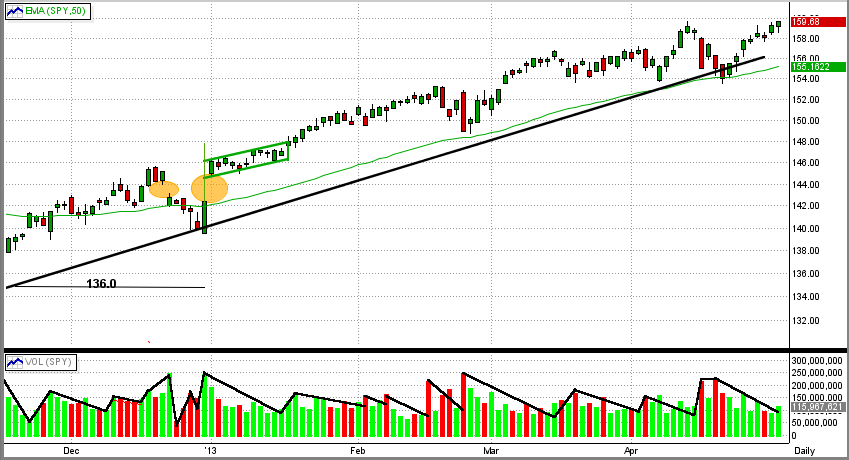
So, what could go wrong? There are many fundamental values that could could derail the market, but that is outside of the scope of this blog (and you can read about that all over the Internet).
From a purely technical standpoint, two things are very dangerous.
1) The first is the 13-year Triple Top that we discussed in the previous email below (see the very last graph).
2) The second is closer to home. In Graph #2 below, you can see the potential formation of a near-term perfect
double top. If the SPY fails at breaking 159.7 to the upside and heads down, this could represent (a) a dreaded
sideways pattern at best, and (b) a double top worst case.
Graph #2
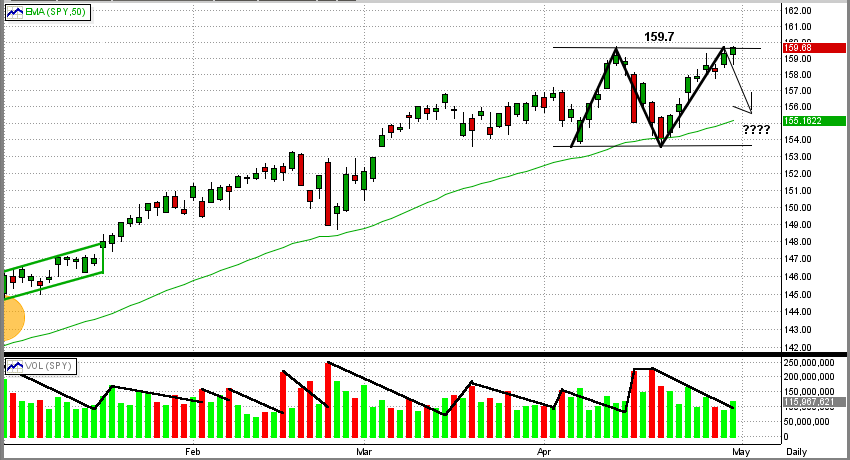
As always, let's wait for MIPS to tell us what do do.
Friday, April 19 2013
Sometimes things just ain't what they seem. You can look at one single thing from two different viewpoints, and it can look like two very different things.
For example, take the recent stock market behavior (Graph #1). When we look at it from a short-term perspective (days/weeks), the recent market looks somewhat violent and erratic. Previously, the market was following a fairly smooth trendline, and recently it seems to be diving. The SPY broke this trendline to the downside today, but bounced back a little and settled right on top of its 50-day EMA. Everyone is jittery about which way the market will go from here. The answer, of course, is not in these numbers. All we are seeing is what engineers call "noise" and not yet a new trend. Trends take longer to develop, and that is what MIPS is all about.
Graph #1
 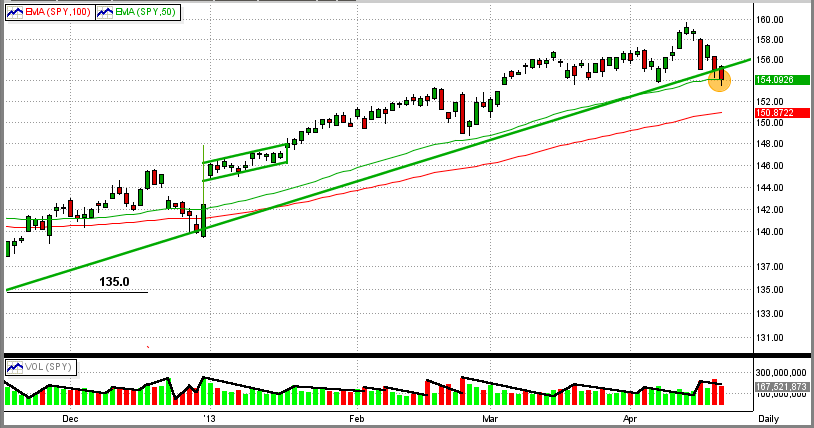
Graph #2
Now, if we look at the very same time frame (last few weeks) on a longer-term scale, it looks like almost nothing is happening recently (last little "bar" on the top right is the entire month of April 2013). But from here we can see that we are "sitting on the fence" of what will most likely be a new, dramatic move. We happen to be sitting on a time-bomb of a 13-year Triple-Top. The SPY hit and stopped going up at almost exactly $157.5/share for the third time in 13 years (2000, 2007, 2013). You can see from Graph #2 that the market does not dilly-dally for long periods at these "tops", mainly because everyone has their finger on the trigger. We all want to move very fast when a new trend (up or down) becomes apparent. So, let's be very attentive and watch for signals from MIPS.
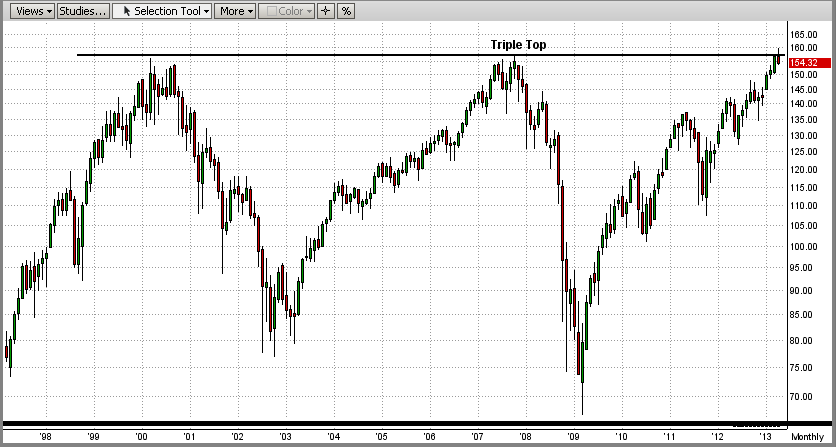
Sunday, April 14 2013
By now, most of you know that we have been working on a new, slightly faster trading model for over six months
- we are most pleased to officially introduce our new "MIPS4/MF+" model
- the name comes from: (a) MIPS4 to identify a new model, and (b) MF+ meaning medium-frequency "plus"
- MIPS4 is an offshoot of MIPS3, but uses algorithms from all MIPS models.
As with all of the MIPS models, with MIPS4 you can trade any ETF that "correlates" well with the SPY
- and, MIPS4 is a little smoother ride than MIPS3 (i.e., with less "volatility")
- as a result, the MIPS4 model produces very "smooth" results.
For this reason, we feel comfortable approving the use of MIPS4/MF+ signals to trade leveraged ETFs.
But, of course, you do NOT have to trade with leverage...
- if you do use leverage, however, we recommend double leverage long, but single leverage short for more
conservative use of leverage.
See the table below for the performance of all of the MIPS models in the time frame of 2003-3/31/13 .

In the graph below, we show MIPS4/MF+ as compared to MIPS3/MF.Improved and MIPS3/MF.org between 2006-03/31/13. M3.org (brown line) in the graph is the performance of the original MIPS3/MF model without the improvements made in 2011-2012.

DOUBLE LEVERAGE
The graph below shows MIPS4/MF+ trading double leverage SPY (SSO) on long signals and single leverage SPY (SH) on short signals. For more performance reports, click on the "Performance" tab on the main menu on our homepage.
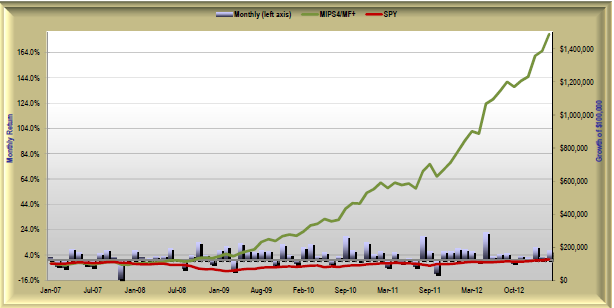
Monday, April 08 2013
It seems as though no one has a strong feeling for where this market will go from here. The market has hit all-time closing highs in the major indices and the retail investors (the "little guys") are rushing back into a market that they missed to the tune of over $100 billion in equities year-to-date. Other things affecting the market now are potential defaults in Greece and Cyprus, financial crises in the other PIIGS countries, interest in what the large institutional investors and retail investors will do next, interest in what the Fed will do next, etc. As always, a large number of issues/circumstances should determine the market's moves from here.
But, is this correct? One could make a strong case that the market behavior from here is not dependent upon the tens of thousands of institutional investors/traders or hundreds of millions of little guys, etc., but mainly on the actions of one man, Ben Bernanke, Chairman of the Federal Reserve.
Supposedly to stimulate the economy, Helicopter Ben has been printing tens of billions of dollars every month ($120B in 3Q'12 alone), with no end in sight. Our national debt rose by over $1 trillion last year, and we have more debt than all of the countries in the European Union combined. This will ultimately throw everything into chaos. At this time, the USA can only afford the interest payments on our national debt because Helicopter Ben is artificially keeping interest rates on mid- and long-term US Treasury bonds extremely low ("Operation Twist"). This, or course, drives bond prices up and overrides the normal reaction of bond prices to the economic outlook. Also, on the equity side, we have high quality companies borrowing money at record low interest rates to buy back their own shares, thus driving their profits in $'s/share higher due to a lower number of shares, even if their profits never changed. How long can this go on without serious consequences? By the way, what the Fed does is NOT subject to the authorization or approval of Congress or the White House (how did we let that happen?).
In his own words, Bernanke’s plan is to quit printing money only when unemployment falls to or below 6.5%. That is kind of like a family in serious debt borrowing more and more money until "things get better", even when the extra borrowing makes the “bad things" worse. How is that for "chasing your tail"? At no time in the past has any nation become more fiscally sound by taking on massive additional debt. Historically, this has only led to high inflation and/or bankruptcy.
In our case, large institutional investors will not sit tight and let this go on indefinitely with no repercussions. Ultimately they will react. Thankfully, MIPS followers do not need to "call the market" themselves. MIPS will follow the market movements (mainly from the big guys by tracking volume), and will follow the new trend. In the last 4+ weeks, the SPY has moved sideways after breaking its all-time closing high. Usually, the size of market moves after breakout from a narrow trading range is somewhat correlated to the longevity of the flat trading range. This market can go higher with QE3 and little guys coming back into the market, but it is going to be an uphill battle breaking above the SPY price of $157.5/share (all-time intraday high).
See the graph below. The market (SPY) has been moving sideways for the last 20+ days (purple rectangle). The pattern of the market during this time has been a series of sizeable drops on relatively high volume (big guys), followed by a complete recovery over the next several days on low volume (little guys). Last Friday, the bears made a gallant effort to put a substantial dent in the market including a down gap on the open followed by a triple digit drop in the Dow, but the bulls spoiled the party by buying it back up to (and a little above) the intermediate-term trend line (long green line).
It’s anybody's guess from here, so we will depend upon MIPS to detect the next meaningful trend and tell us what to do.
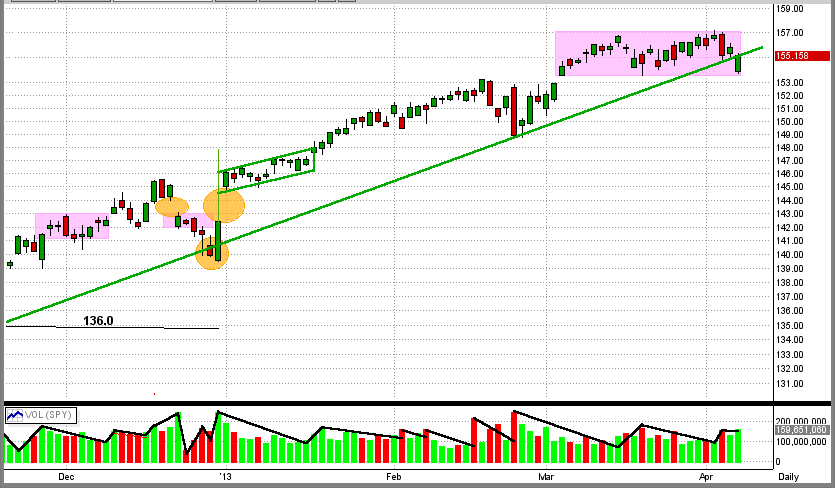
Sunday, March 17 2013
This bull market move is now facing its most daunting situation since 2009. We are fast approaching a point of "Stone Wall" resistance. This "Stone Wall", of course, is the all-time, intraday high for the SPY at $157.5/share on 10/11/07 (about $1565 on the S&P 500).
What makes this so "daunting" is that $157.5/share on the SPY now would complete a very precise, almost perfect 13-year "Triple-Top". See Graph #1 below (scary). If the SPY fails to break through this level to the upside (after a couple or three times), the results could be devastating.
Graph #1
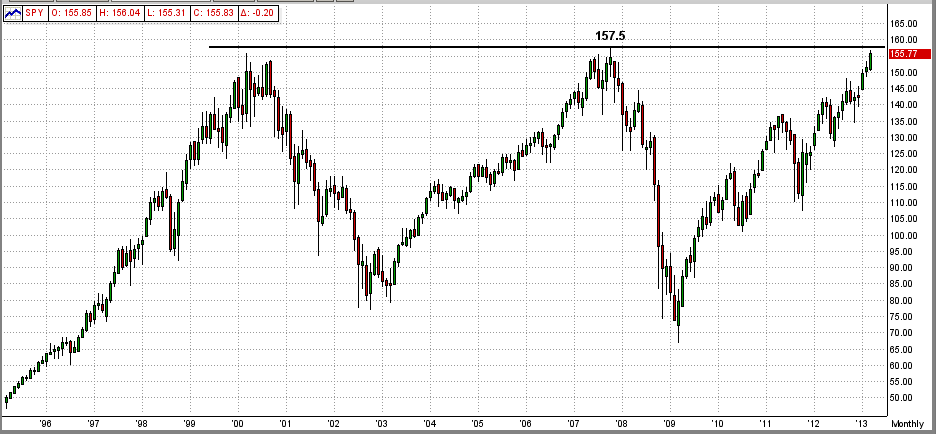
On the other hand, if the SPY does break through to the upside and stays above or goes higher, this could lead to panic buying (or according to Greenspan, "Irrational Exuberance").
For the last few months, the big guys have been selling on high volume and the little guys have been "buying the market" back up. See the volume numbers in Graph #2 below. Other than a couple of pretty weak "bear market traps" (which the MIPS models ignored) this market has been in a very obvious up-trend, and all of the MIPS models have been long since 11/21/12.
Graph #2
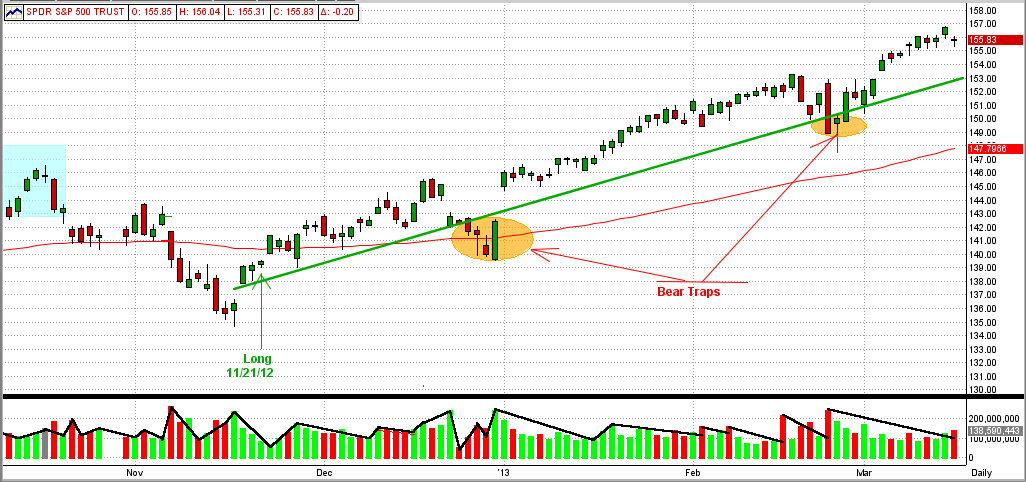 The little guy, big guy behavior
The little guy, big guy behavior above is a little nerve-racking, but remember that the little guys can come in en masse at market tops, and push it a lot higher (a la the NASDAQ in the late 1991's). See Graph #3 below.
Graph #3 (from Traders.com)
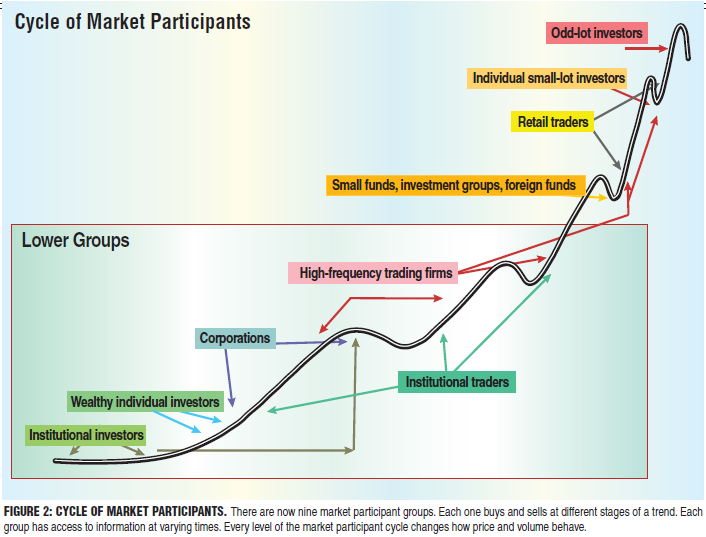
Good Trading !!!
Saturday, March 09 2013
From the outside, it would seem that this market should be going down. Most of the news from all over the world is bad news (or, at the very least, not good). But, the stock market keeps going up. With news like that below, how can this happen?
World News:

What others have to say (Jack's Wrap 3/08/13 - www.swingtradeonline.com)
" Once again, the market could find no sellers. The masses were thinking to sell the Jobs Report if it were good. Who can blame them since the market is so overbought. They were right. It sold. However, once it sold off some from the early morning highs, it was bought up once again. Not to the levels of the early day highs, but no real selling one would think likely after a strong early day pullback and still at overbought. The strength of this market is a bit strange, but you never fight the price action of the market. It speaks above all else. And, the bears have nothing. For crying out loud they can't even get a simple pullback going of 3-5% to unwind grossly overbought oscillators across all time frames."
OK, but that still does not answer the question as to why this market keeps going up. We think it is because the big guys have succeeded in sucking the little guys back into the market near its all-time highs and are hoping to have this turn into "hysterical buying" like in the tech bubble in 2000. We don't really think that anything close to the market behavior in 2000 will happen, but the little guys could easily push the market higher from here. If you look at daily price/volume graph over the last several months, you will see several days where the big guys really sold the market down (down on high volume) and then waited for (and watched) the little guys to push it ever higher (up on low volume).
At lease the big guys have succeeded in bringing the little guys back in the market after they missed gains from the bottom in 2009 of over 125% (see the top right in the graph below). [BTW, see where the big guys buy (bottom left).] In just the first two weeks of 2013, almost 20 billion dollars have moved from bonds and money market funds into US stocks and equity ETFs (Lipper). And guess what, that came from the little guys. See the graph below and you will realize that the little guys have been fooled again !!! They are buying at or near what could be the top (where retail/small investors almost always flock back into the market). The big guys will let the little guys push the market as high as the little guy wants, and then the big guys will dump en masse.
Let's rely on MIPS to keep us in the market on the ride up and get us out in time to make money in the downdraft (aka crash).
From www.traders.com

Monday, February 11 2013
Everyone pretty much agrees that this market is overbought, and most expect a pullback soon. Most likely, investors agree that the market is overbought, but all do not agree on what will happen from here.
When we look at the graph below, we can see that the SPY bottomed out at $134.7/share on 11/19/12 (MIPS3/MF went LONG on 11/23/12). Since then, the SPY:
(a) formed a new intermediate-term uptrend,
(b) broke the then recent triple top neckline at 143.0,
(c) fell into a short 5-day "bear trap" (purple box),
(d) gapped up and formed an up-pennant pattern,
(e) broke out of the up-pennant pattern to the upside, and
(f) formed a new, definitive uptrend.
The resulting performance from the SPY in this wild ride over the last 2-1/2 months is a healthy gain of 12.9%. And, this performance was not restricted to just the large-cap stocks in the SPY, as the Russell 2000 did even better. Of course, Apple put the brakes on the NASDAQ performance, but it was still up nicely.
The above is enough for most traders to declare that "the market" is overbought, at least in the short-term. It would be difficult for anyone to disagree with that. But, as always, there is another sneaky little option hiding in the numbers.
Looking a little closer at the volume during this run-up, we see that the market run-up has been on low volume. For example, the recent SPY volume has been only about 75% of its average volume. This decisively says that the run-up was the result of buying by the little guys rather than the big guys. And, I also believe that this is exactly what the big guys have been waiting for. If this keeps up, and if the SPY reaches or breaks its all-time high of $157.5/share from Oct'07, it could lead to euphoric buying by the little guys who missed the bull market of the last 4 years; thus pushing the market to record highs. Of course, this is exactly what the big guys want. THEN, they will dump their holdings at the very top one more time.
If you don't think this can happen, think again!!! To those who have not been trading for the last 15-20 years, this might not seem possible. But, I was right in the middle of Silicon Valley in the late 1990's when investors pushed Cisco System's stock price up to where its P/E ratio was 400 and Yahoo's market value was higher than the GDP of Iceland. What this shows is that it "is" possible for hyped-up buyers to push an already high, overbought market even higher.
This poses two very different outcomes (also see the take on this by the "pros" in the articles below).
Conclusion: Let's wait for MIPS to determine a new trend and tell us what to do.
Paul Distefano
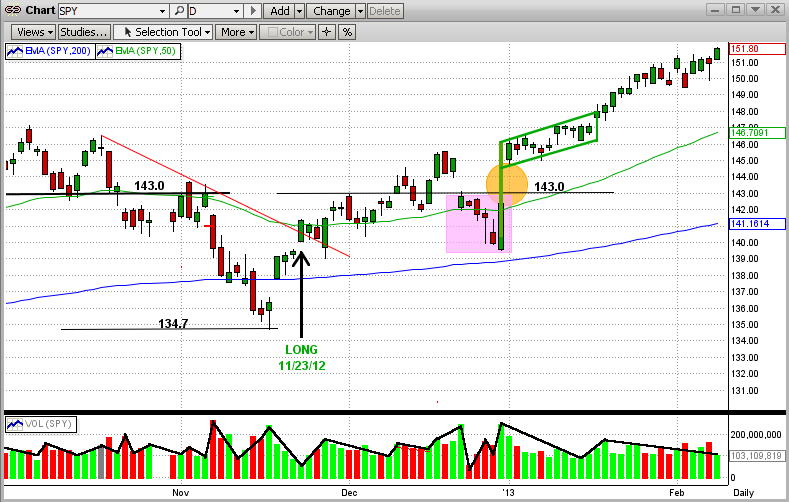
EXCERPTS FROM RECENT ARTICLES
---------------------------------------------------------------------------------------------------------------------------------------------
I. Is This the Death Knell for the Bull Market?
by Alexander Green, Chief Investment Strategist
Friday, February 8, 2013
www.investment-u.com
Well, it had to happen eventually. The average punter is finally returning to the stock market. TD Ameritrade registered an average 370,000 trades per day in January, up from 30,000 trades a day in December. And, according to data from TrimTabs Investment Research, investors funneled $55 billion into U.S. equity funds in January, the most ever for any month on record.
Of course, the big reason average investors are finally warming up to stocks again is: "They've been missing the boat".
Signaling a Top?
Last week the Dow closed above 14,000 for the first time since the financial crisis hobbled the global economy. Small investors - having missed out on the last 7,500 points - don't want to miss any more. Some analysts say the return of the small investor is a signal that the bull market, already nearly four years old, may soon give up the ghost.
Mutual fund flows also just turned heavily toward equities. Does that mean the end is near? History shows that small investors are only a good indicator at market extremes. They tend to be wildly optimistic at market tops and wholly pessimistic at market bottoms.
-------------------------------------------------------------------------------------------------------------------------------------------
II. JACK'S WRAP, Friday, February 08, 2013
Jack Steiman is author of SwingTradeOnline
www.SwingTradeOnline.com
The market continues to perform well overall, but as I have been saying for a while now, there is more and more risk. Just take a look at the weekly RSI's (Relative Strength Index) on the major index charts. While the Nasdaq is low in the lower 60's due its lagging mostly from Apple Inc. (AAPL), most of the other major index charts are just below 70, or actually at 70. When weekly charts get to 70 on those RSI's, it's not great news for the bulls. This does not mean the market will imminently fall hard, but you know it's not too far away. It's definitely out there.
If you look at markets historically, when the weekly RSI's get to 70 on the major index charts, it's prone to selling. The weekly charts are powerful, so, at least, take the time to notice what's happening with sentiment on these charts and play appropriately. Now, even though there are red flags, this doesn't mean you run for shelter automatically and sell everything on the long side. There are some great stock set-ups, and yes, it's harder to get them to do what we'd like as fast as we'd like, but many stocks are performing well and set up to do so in the weeks ahead, overbought weekly charts or not.
|